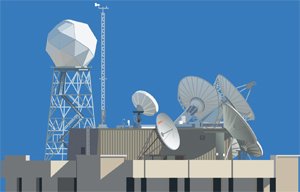Million Dollar Super-Computer Comes to SSEC
The largest, most powerful computer on the University of Wisconsin-Madison campus begins operations in June of 2011. Housed at the Space Science and Engineering Center (SSEC), the new system will contain 3,072 CPU cores, 8 terabytes of RAM, over 450 terabytes of disk space, and a 40 gigabit infiniband network. The system is more than half again as large as any previous campus high performance computer cluster.
Funded by the National Oceanic and Atmospheric Administration (NOAA), the system will be used by NOAA and UW researchers to run data assimilation experiments with the goal of improving the NOAA operational weather models used to generate weather forecasts for the United States.
The NOAA National Environmental Satellite, Data and Information Service (NESDIS), Center for Satellite Applications and Research (STAR), approached Principal Investigator Liam Gumley and his team with a proposal to provide a million dollar grant to design a large, extremely capable system and, upon approval of the design, purchase the hardware. They required that the system be able to run NOAA’s operational, data assimilation, and numerical weather prediction models, and to serve as a test bed to develop and improve the use of satellite measurements in numerical weather prediction.

Stacks of boxes holding the processors and memory units loomed large in the loading dock.
SSEC Technical Computing staff including Jesse Stroik, John Lalande, and Technical Lead Scott Nolin created the design proposal using NOAA’s parameters and critical guidance from Science Lead Brad Pierce and other SSEC scientists. When the design was approved by NOAA, the team procured the equipment.

The interior of a Dell unit.
SSEC provides complete administration services for the system. 90% of the system’s capacity will be used by NOAA’s STAR researchers. The other 10% is assigned to SSEC.

Endre Doeringsfeld and Paul Czerniak install a component.

The supercomputer system will be used to enhance the accuracy of weather prediction systems through improved use of satellite data within the U.S. operational data assimilation and forecast systems, at global and regional scales. Applications include studying the impact of future observing systems, such as the Advanced Baseline Imager on future GOES satellites, on the forecast skills of U.S. Numerical Weather Prediction models.
NOAA’s desire is for a top-flight system that is accessible and easy to use, and SSEC and the University of Wisconsin is working hard to meet those goals.
Back to Front Page

